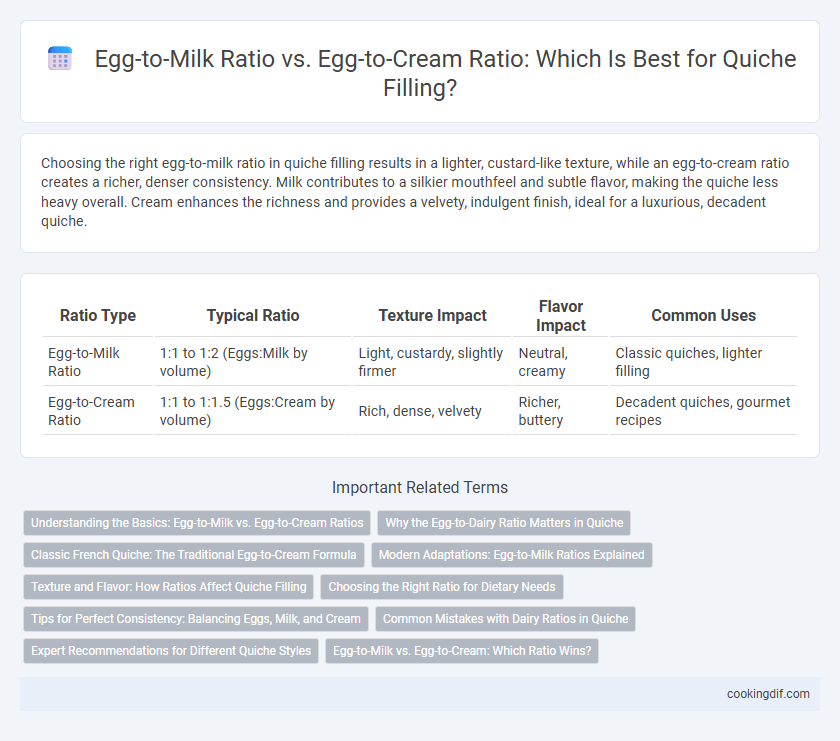Choosing the right egg-to-milk ratio in quiche filling results in a lighter, custard-like texture, while an egg-to-cream ratio creates a richer, denser consistency. Milk contributes to a silkier mouthfeel and subtle flavor, making the quiche less heavy overall. Cream enhances the richness and provides a velvety, indulgent finish, ideal for a luxurious, decadent quiche.
Table of Comparison
| Ratio Type | Typical Ratio | Texture Impact | Flavor Impact | Common Uses |
|---|---|---|---|---|
| Egg-to-Milk Ratio | 1:1 to 1:2 (Eggs:Milk by volume) | Light, custardy, slightly firmer | Neutral, creamy | Classic quiches, lighter filling |
| Egg-to-Cream Ratio | 1:1 to 1:1.5 (Eggs:Cream by volume) | Rich, dense, velvety | Richer, buttery | Decadent quiches, gourmet recipes |
Understanding the Basics: Egg-to-Milk vs. Egg-to-Cream Ratios
The egg-to-milk ratio in quiche filling creates a lighter, more custard-like texture due to milk's lower fat content, typically using about one egg to half a cup of milk. In contrast, the egg-to-cream ratio, often one egg to a third cup of cream, produces a richer, denser filling with a luxurious mouthfeel thanks to the higher fat in cream. Understanding these ratios is essential for customizing quiche texture and flavor intensity to suit different recipes and personal preferences.
Why the Egg-to-Dairy Ratio Matters in Quiche
The egg-to-dairy ratio in quiche filling directly influences texture, richness, and structural integrity; higher egg content yields a firmer, custard-like consistency, while more dairy softens the filling and adds moisture. Milk typically produces a lighter, silkier quiche, whereas cream enhances creaminess and depth of flavor due to higher fat content. Balancing eggs with the appropriate amount of milk or cream is essential for achieving a quiche that holds together without becoming rubbery or overly dense.
Classic French Quiche: The Traditional Egg-to-Cream Formula
Classic French quiche filling traditionally features a precise egg-to-cream ratio, typically 3 eggs to 1 cup of heavy cream, ensuring a rich and silky texture. This egg-to-cream formulation contrasts with the egg-to-milk ratio, which yields a lighter, less custardy consistency commonly used in other quiche variations. Maintaining the traditional 3:1 egg-to-cream balance is key to achieving the signature velvety custard characteristic of authentic French quiche Lorraine.
Modern Adaptations: Egg-to-Milk Ratios Explained
Modern quiche adaptations often adjust the egg-to-milk ratio to achieve a lighter, custard-like filling compared to the richer texture produced by higher egg-to-cream proportions. Typical egg-to-milk ratios range from 1:1.5 to 1:2, balancing structure with a tender, silky consistency. Experimenting within this range allows bakers to customize moisture and firmness, optimizing flavor and mouthfeel without compromising the delicate quiche custard.
Texture and Flavor: How Ratios Affect Quiche Filling
The egg-to-milk ratio in quiche filling creates a lighter, custard-like texture with a milder flavor, while a higher egg-to-cream ratio results in a richer, denser consistency and more intense flavor. Balancing eggs with milk produces a smoother mouthfeel and subtle taste, ideal for delicate fillings, whereas incorporating cream enhances silkiness and adds depth to savory profiles. Adjusting these ratios directly influences the quiche's overall texture and flavor complexity, allowing for customization according to desired culinary outcomes.
Choosing the Right Ratio for Dietary Needs
Selecting the ideal egg-to-milk ratio versus egg-to-cream ratio in quiche filling directly impacts texture and nutritional content, making it essential for tailoring to dietary needs. A higher egg-to-milk ratio creates a firmer, protein-rich quiche suitable for low-fat diets, while increasing cream produces a richer, higher-fat custard ideal for ketogenic or calorie-dense meal plans. Balancing these ratios enables customization of moisture, fat, and calorie levels to accommodate preferences such as low-cholesterol or high-energy diets.
Tips for Perfect Consistency: Balancing Eggs, Milk, and Cream
Achieving the perfect quiche filling consistency hinges on balancing the egg-to-milk and egg-to-cream ratios, with a typical guideline being 3 large eggs to 1 cup of dairy. Using milk results in a lighter, custard-like texture, while cream adds richness and a velvety mouthfeel, so adjusting based on desired decadence is essential. For ideal firmness without curdling, maintain about a 4:1 ratio of eggs to cream or a 3:1 ratio of eggs to milk, ensuring smooth, tender quiche layers.
Common Mistakes with Dairy Ratios in Quiche
Common mistakes with dairy ratios in quiche include using an incorrect egg-to-milk or egg-to-cream ratio, which affects texture and firmness. An overly high milk ratio results in a runny filling, while excessive cream leads to a dense, heavy custard that can overpower other ingredients. Balancing eggs with dairy--typically one egg per 1/2 cup cream or 3/4 cup milk--ensures a smooth, tender quiche filling that sets properly without curdling or sogginess.
Expert Recommendations for Different Quiche Styles
Expert recommendations for quiche filling emphasize the egg-to-milk ratio of 1:1 for a classic custard-like texture, ideal for traditional quiche Lorraine. For richer, creamier fillings typical of gourmet or decadent quiches, an egg-to-cream ratio closer to 1:1.5 is preferred, enhancing silkiness without overpowering the savory ingredients. Adjusting these ratios allows chefs to tailor the quiche style, balancing firmness and creaminess to suit specific flavor profiles and textures.
Egg-to-Milk vs. Egg-to-Cream: Which Ratio Wins?
The egg-to-cream ratio in quiche filling produces a richer, silkier texture due to cream's higher fat content, enhancing flavor and mouthfeel. In contrast, the egg-to-milk ratio yields a lighter, more custard-like consistency with a balance of creaminess and subtle freshness. For a custard that holds structure firmly while maintaining indulgence, many chefs prefer the egg-to-cream ratio, but those seeking a delicate, less dense quiche often choose egg-to-milk.
Egg-to-Milk Ratio vs Egg-to-Cream Ratio for Quiche Filling Infographic

 cookingdif.com
cookingdif.com